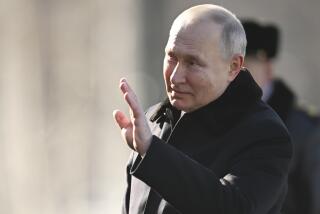Ambiguity Swaddles Bush’s Missile Plan
- Share via
President Bush raised more questions than he answered in his speech last week on missile defense. While he committed himself to developing an anti-missile system, he failed to say what that system would look like, what it would cost or when it might be deployed. He also said it was time to move beyond the Antiballistic Missile Treaty, signed during the superpower arms race of the Cold War. But he failed to say what should replace it.
Bush is right that the U.S. needs a missile defense for itself and its allies--just as it needs better defenses against suitcase bombs, terrorists and a variety of other threats to the nation.
But there’s a right way and a wrong way to proceed. The right way is to build a system targeted at the definite but limited threat that potential new ballistic missile powers such as North Korea could pose. The wrong way is to try to develop a “Son of Star Wars” system aimed at stopping large-scale attacks.
Such a system is unlikely to work, would divert resources from other pressing defense needs and would actually aggravate the nuclear and missile threat to the U.S.
Because Bush’s speech was long on rhetoric but short on detail, it can be read as endorsing either approach.
In discussing the threat, he emphasized the spread of ballistic missile technology to “states for whom terror and blackmail are a way of life.” (Although Bush did not name these states, he presumably had countries such as North Korea and Iran in mind.)
He also went out of his way to emphasize that although the U.S. has differences with Moscow, today’s Russia is not Washington’s enemy.
He reiterated his pledge to seek reductions in the size of U.S. and Russian nuclear forces--which now number around 7,000 warheads on each side--and indicated his willingness to make unilateral cuts to jump-start the process.
And he talked about his hopes of creating a new strategic “framework” with Moscow, which he said “should be premised on openness, mutual confidence and real opportunities for cooperation.”
But Bush’s speech also can be given a darker reading. Much of it was a sustained attack on the ABM treaty.
He is right that many of the treaty’s specific provisions have outlived their usefulness. But its core principle--that the United States and Russia both benefit from the predictability that comes with having some type of real constraints on what they can do--remains valid.
In speaking of replacing the ABM treaty with a “new framework,” Bush gave no hint whether he would be willing to accept any constraints on U.S. behavior. Why Moscow should find such a stance reassuring, or why an unconstrained Russia serves U.S. interests, is unclear.
Equally important is what wasn’t in the speech. Despite expectations to the contrary, Bush did not announce a specific numerical target for his proposed cuts in offensive nuclear weapons.
He failed even to say that he supported the reduction to between 2,000 to 2,500 warheads that Bill Clinton and Boris N. Yeltsin agreed to in 1997. With Moscow willing to maintain 1,000 warheads or less, this was a major opportunity lost.
Bush also made no effort in his speech to reassure the Chinese that his proposed missile defense is not aimed at them. In light of recent tensions over Taiwan, this is perhaps understandable. But given that Beijing has ample means by which to make the U.S. pay for running roughshod on its strategic interests--most obviously by increasing its support for nuclear proliferation--the failure to say that the administration does not consider China a “state of concern” is a bad and self-defeating idea.
Bush may have given a speech swaddled in ambiguity because he hasn’t yet decided what he wants to do, or because he wants to maximize his bargaining leverage with Moscow and others, or because he wants to build a big and bold system without stirring up political opposition.
It is now time for Congress and U.S. allies to push him to embrace a limited defense aimed at real threats rather than allow him to follow administration hard-liners who seemingly want to revive Ronald Reagan’s unbridled “Star Wars” concept.
More to Read
Sign up for Essential California
The most important California stories and recommendations in your inbox every morning.
You may occasionally receive promotional content from the Los Angeles Times.













